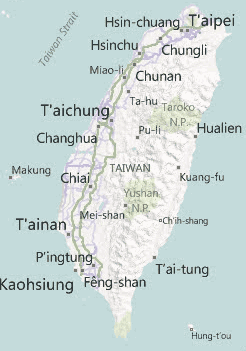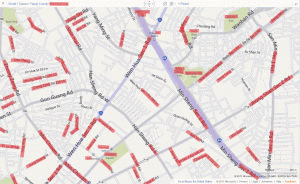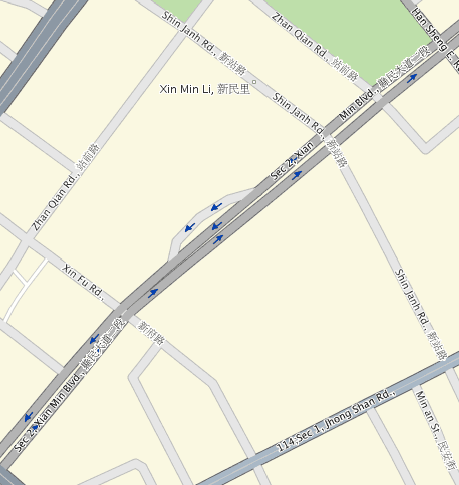Santa’s in his bus and all’s right with the world.
Although coach buses in Taiwan often use the Gwoyeu Romatzyh romanization system, this bus uses “SAN TA” for “三大”, which is Wade-Giles.

Santa’s in his bus and all’s right with the world.
Although coach buses in Taiwan often use the Gwoyeu Romatzyh romanization system, this bus uses “SAN TA” for “三大”, which is Wade-Giles.
Although in posts mentioning Gwoyeu Romatzyh I often note that romanization system can be seen in the wild in Taiwan most often on the sides of coach buses, I haven’t put online many examples of this. So here’s an image-heavy post with some examples of photos I’ve taken of the Gwoyeu Romatzyh romanization system on buses in Taiwan.
The captions give the Gwoyeu Romatzyh, along with the Hanyu Pinyin (with and without tone marks) in parentheses.
My previous post on postage stamps with Bopomofo (Zhuyin fuhao) mentioned Taiwan’s postal service, Chunghwa Post, which is terrifically efficient at delivering mail but which made an odd choice in romanization in its English name however many years ago . The Mandarin is Zhōnghuá Yóuzhèng in Hanyu Pinyin. But the post office spells its name
Chunghwa
Chung is clearly Wade-Giles. (It probably would be bastardized Wade-Giles; but in this case chung rather than ch’ung is correct – so, luck of the draw.) Yet hwa does not exist in Wade-Giles, which uses hua. So where is that hwa coming from? The only system that uses hwa and has been official in Taiwan is Gwoyeu Romatzyh.
The Yale system, devised by George Kennedy, also uses hwa; but despite occasional confusion by reporters and others, Taiwan has never used the Yale system. Instead, what many people mistakenly believe is Yale is instead MPS2.
I’m afraid, though, that I don’t have a definitive answer for how Taiwan ended up with the portmanteau spelling of Chunghwa. I suspect that what happened is that the initial intention was to go with the country’s official romanization system, which, way back when, was Gwoyeu Romatzyh (“GR” for short), even if you wouldn’t know that from signage or maps or just about anything but long-distance buses. But using GR would have yielded Jonghwa, which would likely struck people accustomed to seeing 中 romanized as chung as “looking weird” (even though chung is hardly an intuitive spelling for native speakers of English for what is zhong in Hanyu Pinyin). So they kept the chung but then went ahead with hwa, which is not so different than Wade-Giles’s hua. At least that’s my guess, based on having followed romanization in Taiwan for decades.
The odd choice of Chunghwa is not limited to just the postal system. The main telephone system uses it as well: Chunghwa Telecom.
If Taiwan ever gets a broader rectification of names under which the Republic of China (Zhōnghuá Mínguó) — not to be confused with the People’s Republic of China (Zhōnghuá Rénmín Gònghéguó) — is simply called “Taiwan,” that would likely remove the issue. The spelling of Taiwan is certainly standard and the same across most romanization systems – with the notable exception of Gwoyeu Romatzyh, which would give us Tairuan. (GR’s fuunny sperlinqs strike again!)
I know what you’re thinking: “Man, look at the weird romanization in that address!” ;-)
Say what you will against the Gwoyeu Romatzyh romanization system for Mandarin (or “GR” for short) — its quirkiness, its unnecessary complications, its counter-intuitiveness for those who don’t know its rules (much more so than with Hanyu Pinyin). But at least in the few instances where it’s still seen in the wild, it’s usually spelled correctly.
That’s not the case here.
The address for the manufacturer, the Health Chemical Pharmaceutical Co., Ltd., is given as
No.12, Yeou-4th Rd., Ta-Chia Yowshy Ind. Dist.
大甲工業區幼四路12號
This is definitely misspelled Gwoyeu Romatzyh rather than a different system (such as MPS2, which is often seen in the boondocks of Taiwan).
And the city name is given as “Taichung,” which is bastardized Wade-Giles (for what would be spelled “Taizhong” in Hanyu Pinyin). But since that is the standard spelling in Taiwan, one can’t blame the company for this.
And at least the company didn’t get “4th” wrong, which is more than can be said for the Taichung City Government, as shown by a sign near the factory. (From Google Street View.)
The source of the other misspellings will likely remain enema-migmatic.
Eel Chyi
Here’s a sign spotted in Banqiao, Taiwan, for what would be written “Ěrqí” in Hanyu Pinyin.
“Ěrqí shíshàng” means “Erqi Fashion” (爾旗時尚), with the first word pronounced roughly like the English name “Archie.”
The doubled vowel (“ee”) is a marker of the Gwoyeu Romatzyh romanization system (or “GR” for short), in which doubled vowels indicate the third tone. Thus, “ee” in Gwoyeu Romatzyh equals “ě” in Hanyu Pinyin. As for the -l, that’s GR’s way of indicating -r. For those of you wondering why GR didn’t just use -r for -r, that’s because GR uses -r to indicate second tone … except when it uses other letters to do the same thing. It’s kinda complicated. For example:
And
Of course, Hanyu Pinyin’s q isn’t intuitive for most people used to reading in an alphabetic script but must be learned. Once learned, though, q is entirely consistent. And it must be noted that as quirky as Gwoyeu Romatyzh can be, its oddities are nothing compared to those of Chinese characters.
Although Gwoyeu Romatzyh was technically the ROC’s official romanization system for most of the twentieth century (through 1986), it’s very seldom seen in Taiwan. The most common place for it to appear is on the side of coach buses. But here’s an example of Guoyeu Romatzyh on a shipping box for thousand-year-old eggs:
SONG HUA PYIDANN
Guoyeu Romatzyh is often most easily identified by the doubled vowel in most (but not all) third-tone syllables. But this example doesn’t have any of those. The y indicates second tone (except when it doesn’t). And the doubled final n is a marker of fourth tone. (Have I ever mentioned that Gwoyeu Romatzyh often reminds me of “The Name Game“?)
In Hanyu Pinyin, songhua pyidann is sōnghuā pídàn.
Another technical point, this photo wasn’t taken in Taiwan proper but rather on Kinmen (金門), which provides an example of a romanization system older than Gwoyeu Romatzyh, older than Wade-Giles even. It’s postal romanization, which I regard as too mixed up to properly be called a system. In Hanyu Pinyin, Kinmen is Jinmen. The island is also known as Quemoy.
A doubled vowel is a sure sign of the Gwoyeu Romatzyh romanization system — except when it’s a sign of someone wrongly omitting an apostrophe in Hanyu Pinyin or simply making a typo. But today’s example is certainly Gwoyeu Romatzyh, as, oddly enough, the side of a coach bus is one of the most likely places in Taiwan to spot an example of that romanization system. I’m seeing it less and less as the years go by, though, which saddens me.
Here, however, is a nice example that looks fairly new. I took the photo along Taidong’s lovely coastline a couple of weeks ago.
Diing Dong Bus (Pinyin: Ding3 Dong1; lit. ancient three-legged round cauldron, east)
Note, too, the mixing of Mandarin and English (rather than the loanword form of bashi), and those hideously misplaced g’s.
The maps of Taiwan put out by GooGle are plagued with errors in their use of Pinyin. But what about that other big company with deep pockets? You know: Microsoft. How good a job does Microsoft’s Bing do with its maps of Taiwan?

I won’t keep y’all waiting: After examining Bing’s maps of Taiwan the two words that came first to mind were incompetent and atrocious.
The country-level map is odd, offering Wade-Giles. And although the use of the hyphen is irregular, I will give Bing points for getting at least Wade-Giles’ apostrophes right. So, although some place names on the map are decades out of date (e.g., Hsin-chuang, Chungli, Chunan, Kuang-fu), at least they’re not horribly misspelled within that system.
It’s at the street level that Bing’s weirdness becomes most apparent. For example, below is part of Bing’s map of Banqiao.
I added the highlighting.
This tiny but representative fragment of the map has not one but four romanization systems:
A few more points about this small fragment of the map:
So that’s four systems, plus additional errors.
There’s much, much more that’s wrong with this than is right. That’s even more evident on a larger map — and that’s without me bothering to mark orthographic problems in the Pinyin (e.g., Wen Hua instead of the correct Wenhua).

Here bastardized Wade-Giles (e.g., “Mrt-Hsinpu” at top, center — and, FWIW, in the wrong location) has been added to the mix, making a total of five different romanization systems, as well as some weird spellings, e.g., U Nung, Win De, Bah De, Ying Sh — and that’s without including my favorite, JRLE, because that one is correct in MPS2 (“Zhile” in Hanyu Pinyin).
The main point is that vast majority of names are spelled wrong. And among the few that are spelled correctly, those that are written with correct orthography can be counted on one hand. So, to the words above (incompetent and atrocious) let me add FUBAR.
The copyright statement lists not only Microsoft but also Navteq. The Taiwan maps on the latter company’s site, however, are different from those on Bing. Navteq’s are generally in Hanyu Pinyin, though almost invariably improperly written (e.g., Tai bei Shi, Ban Qiao Shi). And despite the prevalence of Hanyu Pinyin, they still contain other romanization systems (e.g., Jhong Shan) and outright errors (e.g., Shin Jahn).

So an update from Navteq wouldn’t be nearly enough to fix Bing’s problems, which are fundamental.